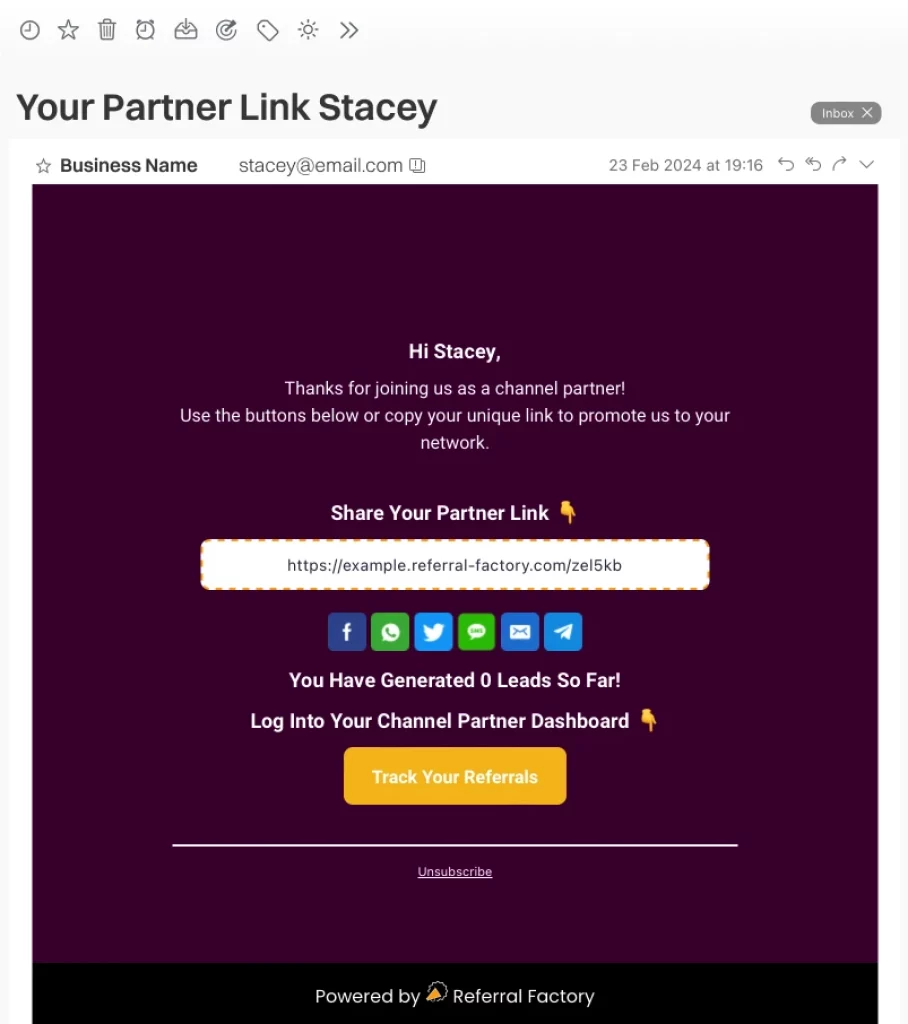How To Start A Channel Partner Program
A channel partner program… Three words that offer so many benefits – tapping into new markets, getting new leads, achieving sales targets, and scaling your business. Sounds like a dream, doesn’t it? But psst! There are even more opportunities you can get.
We’ll talk about that further, but first – what’s all this channel partnership about? Simply put, this is a unique collaboration between your company and external parties to promote your products or services.
Of course, developing a perfect strategy is easier said than done (as usual). Still, no worries! In this article, we’ve highlighted and detailed all the main steps on your way to success. After mastering these basics, you will only need to set up proper referral tracking. And then, you’ll notice how building a channel partner program becomes an easy and exciting task.
Table of Contents
Key Takeaways
Channel partner programs are vital for business expansion, offering benefits such as increased efficiency, sales reach, revenue, and market access, and are projected to contribute significantly to the global economy by 2030.
Successful channel partner programs depend on strategic partner selection, strong channel agreements, extensive support and resources, and effective tracking with tools like Referral Factory.
Maintaining a channel partner program requires overcoming conflicts and challenges through communication, motivating partners with incentives, and measuring success with KPIs to evaluate partner performance and program impact.
Understanding Channel Partner Programs
Strategic partnerships form the backbone of any successful business. Channel partner programs act as a catalyst, connecting businesses with third parties to drive revenue and expand product distribution. Such programs serve as bridges, connecting a business with unexplored territories and untapped market potential. They have the potential to:
Improve operational efficiency
Extend sales reach
Generate more revenue
Provide scalability for rapid business growth
Offer access to new audiences and specialized expertise
Channel partner programs can catapult businesses to new heights by offering their own channel partner program benefits through effective channel sales strategies.
The potential of channel partner ecosystems is massive. By 2030, they are projected to generate approximately $80 trillion in annual revenue, which is roughly one-third of the global economy. This underscores the immense potential and power of channel partner programs.
However, a channel partner program doesn’t guarantee success automatically. It requires careful planning and execution. The cornerstone of successful channel partner programs lies in choosing partners who align with the company’s value proposition and customer value creation.
Types of Channel Partners
Channel partners come in various shapes and sizes, each playing a unique role in enhancing market reach and customer satisfaction. They include:
Retailers
Independent software vendors
Original equipment manufacturers
System integrators
Consultants
Managed service providers
Value-added resellers
Distributors
Agencies
Value-added Resellers (VARs)
Within this diverse ecosystem of channel partners, Value-added Resellers (VARs) carve a unique niche. VARs go beyond traditional reselling by offering additional value through customization, integration, and support services. They tailor solutions to meet customer needs by combining different products into comprehensive bundles and offer services such as installation, training, ongoing support, and maintenance.
VARs are equipped with professional services for product implementation and customer support, often boasting a technical team capable of deploying and configuring products. They represent a holistic approach to solutions, often carrying other product lines that enhance the overall solution. This includes:
Security
Power management
Network storage
And more
Managed Service Providers (MSPs)
Managed Service Providers (MSPs) are yet another essential cog in the channel partner ecosystem. MSPs offer outsourced IT services and manage clients’ technology infrastructure, applications, and systems. They provide:
IT and end-user system management
Network and infrastructure management
Security
Monitoring
MSPs play a critical role in ensuring data security and compliance with industry regulations, particularly in sectors like finance. They offer infrastructure management, proactive support, and scalable solutions that can adapt to a company’s changing needs.
Today, MSPs have shifted their focus from pure product reselling to offering a broad set of IT services that include monitoring, managing, and administering customer networks. They benefit from licensing models that allow them to use software for the benefit of their customers, with costs often being transparent to the customer. They make money by selling their services into which they’ve bundled the cost of software or other products.
Long-term service opportunities allow partners to generate revenue beyond sales and enhance the customer experience.
Independent Software Vendors (ISVs)
Independent Software Vendors (ISVs) also play a crucial role in channel partnerships by:
Enhancing the reach of digital products
Creating new market opportunities
Crafting specialized software solutions aimed at particular market niches or industry-specific challenges
Paving the way for channel partners to explore new sectors.
ISVs focus on delivering a rich customer experience by offering a diverse array of software and Software-as-a-Service (SaaS) solutions to meet business and technical needs. By collaborating with solution providers like telecom carriers and internet service providers, ISVs contribute to ecosystems that facilitate the expansion of IT environments, including hybrid and multi-cloud structures, with their specialized tools and knowledge.
Building Your Channel Partner Program
Developing a successful channel partner program involves several key steps:
Strategic partner selection
Role and expectation definition
Resource provision
Referral tracking
It’s like assembling a complex jigsaw puzzle where every piece must fit perfectly to reveal the bigger picture.
Step 1: Identifying Potential Partners
The journey begins with the identification of potential partners. This requires a deep understanding of the ideal partner profile, which is beneficial for small or medium businesses in creating targeted strategies for retention. Partners should be evaluated based on their market access, audience reach, and the suitability of their distribution method for the product or service.
Identifying partners like VARs and MSPs is crucial for a complementary partnership. Prioritizing carefully selected partnerships should focus on:
Quality representation of the brand
Integration of additional products
Innovation of services
Wider product reach through distributors
Step 2: Establishing Channel Partner Agreements
After identifying potential partners, establishing channel partner agreements becomes the next step. These agreements are binding contracts between the business and its partner outlining:
the partnership
expectations
obligations
processes
The agreement holds both parties accountable and partners need to read, understand, and sign it before doing business with the company.
Channel partner agreements should clearly define the responsibilities and expectations between the business and its partners, ensuring a mutual understanding of each party’s role. They must include:
A glossary of terms to ensure clarity on the legal or marketing terms used
Confidentiality sections for protecting proprietary technology
Details on the partnership’s duration, authorization dates, and any geographic limitations for marketing the products
Compensation details
Tax status
Clear goals and expectations
Termination clauses
The process of standardizing these agreements allows the company to manage them efficiently and adapt quickly to market changes. Steps for standardizing agreements include adopting a partnership mindset, evaluating effective language from previous agreements, and allowing room for negotiations.
Well-structured contracts with clear expectations and flexible terms are motivating for new or smaller partners.
Step 3: Providing Support and Resources
Another key aspect of building a successful channel partner program is effective partner support. Training and support programs are crucial, enabling partners to be well-informed and efficient in delivering the brand’s message, thereby representing the brand effectively.
Providing white papers, educational content, sales playbooks, and successful channel enablement strategies supports partners in understanding business insights and improving sales efforts. Regular updates, newsletters, webinars, and enhanced collaboration through communication tools foster a deeper commitment from channel partners.
Partner portals and partner relationship management software (PRM) tools are vital for maintaining trust, organizing documents, and keeping partners informed about company news and product updates. Providing comprehensive technical and sales assistance before, during, and after the sale supports partners’ business growth and drives success for both partners and the company.
Step 4: Tracking Channel Partner Referrals Using Referral Factory
Another key step in constructing a successful channel partner program is the tracking of channel partner referrals. When using Referral Factory, you can easily generate referral links for each of your channel partners so they can spread the word about your business to their network.
These referral links open a custom lead generation form that allows you to track the incoming leads back to the correct channel partner.

This tracking means you can understand all the key analytics (conversion rate, reach, etc.). On top of that, you can even automatically pay your channel partners using the Referral Factory. The whole system is no code, meaning that you can get this up and running without needing a developer!
But of course, the main functionality you need is tracking. In Referral Factory, we use tracking pages for that. Here, your channel partners can go to check their results – conversion rates, rewards, and more. In other words, they get access to their referral metrics, such as how many people they’ve invited and who has converted.
Now, let’s see how it works in practice. There are 4 options on how to access the referral tracking link.
Option #1
Select the Campaigns tab from the left-side menu.
Open the campaign you want to track.
Click the Tracking Pages button.
Click Copy and share your tracking link with your referrals.
Option #2
Start by clicking the Edit Tracking Pages button.
Select Settings from the bottom bottom navigation bar.
Click Copy and share your referral tracking link with the users.
Option #3
Another way to access a tracking link is by adding /referrals at the end of your campaign link. How does it work in practice?
Go to your Campaign tab > Promote Your Campaign (the bottom navigation bar)
Suppose your campaign link looks something like this: https://yourbusinessname.referral-factory.com/jcFBBO
After adding /referrals, your tracking link will look like this: https://yourbusinessname.referral-factory.com/jcFBBO/referrals
Copy this link and share it with your users.
Option #4
Every person referring can easily keep track of their referrals via the referral tracking link inside the email notifications they receive when starting to participate in a channel partner program (or any referral campaign).
This how an email might look👇

Still, the tracking story wouldn’t be complete without Google Analytics. You can easily integrate it to get more detailed information on how users are interacting with your campaign. It takes just a few simple steps.
1. Open the dashboard > click the Settings tab in the left-side navigation bar.
2. Scroll down the page to find a section called Google Analytics.
3. Add your Google Analytics Account ID and click Save.

4. Click Campaign in the left-side navigation bar > select the campaign you need > click Edit Campaign.

5. In the Settings section, scroll down the page until the drop-down part called Activate Facebook Pixel and Google Analytics and expand it.
6. Switch on the toggle switch to enable Google Analytics for the selected campaign.
That’s it. Simple, isn’t it? Well, now you know how to track your channel partnership effortlessly.
Measuring the Success of Your Channel Partner Program
Measuring the success of a channel partner program involves devising key performance indicators (KPIs) that accurately track and align with the program’s success factors. Some key metrics to consider include:
Overall revenue contribution from each partner
Number of new leads generated by each partner
Conversion rate of leads to sales for each partner
Customer satisfaction ratings for each partner
Time to market for new products or services through each partner
These metrics will help you assess the effectiveness of your channel partner program and make informed decisions to drive its success.
Performance metrics that can be used to evaluate the effectiveness of partners include:
Average deal size
Deal registration rate
Goal and quota attainment
Lead response time
MQL to SQL conversion rates
Partner-generated opportunities
Win rates
CSAT scores
Awareness of competitor affinity
These metrics provide insights into the success of each partner and can help identify areas for improvement.
Pipeline activity and sales metrics provide critical data for gauging the health of the sales pipeline and analyzing each partner’s performance in the sales process. An overarching evaluation of channel partner program success is based on clear, measurable goals, which include:
Assessing financial fitness
Evaluating strategic strength
Analyzing operational performance
Identifying opportunities for learning and growth
Overcoming Challenges in Channel Partner Programs
Every journey comes with its own challenges, and developing a successful channel partner program is not exempt from this. Channel partner conflicts, such as competition over deals, can strain relationships with both partners and direct sales teams. A clear conflict resolution process is crucial to preventing channel conflict, addressing grievances, and preserving the integrity of partnerships.
Pricing conflicts with channel partners may lead to undercutting and can jeopardize the partnership. A decline in channel partner performance may indicate a need to audit the channel program to understand partner compensation and motivation. Regular training, incentives, and focused attention from channel managers are vital to keep channel partners engaged and your products top of mind.
Evaluating active, pending, and inactive channel partners using metrics can help channel managers stimulate engagement and optimize partner contributions. Disorganized data and assets can cause inaccurate tracking of partner sales and lead to ineffective distribution of leads and resources. Virtual communication tools, such as video conferencing, are key to overcoming collaboration challenges with channel partners.
Creating a feedback loop with channel partners fosters transparency and shows that their input is valued for the continuous improvement of the program. Transparency and open communication with partners are fundamental to building stronger relationships and resolving any issues effectively.
Strategies for Partner Motivation and Retention
The importance of retaining and motivating partners is just as paramount as their acquisition. Understanding partners’ strategic goals and providing relevant programmatic elements enhances their success and fosters a culture of partnership. Offering a range of incentives, including competitive commissions, exclusive discounts, and recognition through awards or public acknowledgments motivates channel partners and encourages long-term commitment.
Maintaining frequent communication through regular feedback sessions, webinars, and live Q&A enhances partner engagement and fosters a community. Providing partners with access to sales tools, and personalized training, and fostering a culture of innovation empowers them and demonstrates a commitment to their growth. Enable partners to thrive by offering these resources and support.
Engaging partners through hosting partner retreats, offering co-marketing opportunities, and encouraging peer-to-peer learning within the partner ecosystem drives collaboration and brand cohesion. Implementing a gamified approach with point systems and competitive tiers incentivizes partner sales efforts and adds an engaging dynamic to the partner program.
Summary
In conclusion, building a successful channel partner program is not a walk in the park. It requires a strategic approach, from identifying potential partners and establishing a clear channel partner agreement to providing the necessary support and resources. It’s about fostering a culture of collaboration, overcoming challenges, and continuously measuring success. But with the right strategies and tools in place, the journey can be rewarding, bringing numerous benefits, including expanded market reach and increased revenue.
Frequently Asked Questions
What is an example of a channel partner?
An example of a channel partner is a company, such as a reseller or vendor, that partners with another organization to market or sell their products or services. This can include dealer partners in the Ag machinery manufacturing industry or VARs partnering with distributors to source IT products.
How do channel partners make money?
Channel partners make money by promoting a vendor’s products or services and earning a commission for every sale they generate through their marketing efforts.
How do I start a channel partner business?
To start a channel partner business, you need to create a value proposition, select channel partners, reach out to them, create a partner agreement, agree on success metrics, and establish an onboarding process. These steps will help you establish and grow your channel partner business successfully.
What is a channel partner program?
A channel partner program is a business initiative that partners with third parties to expand product distribution and drive revenue, aiming to improve operational efficiency, extend sales reach, generate more revenue, and provide access to new audiences.
What are some types of channel partners?
Channel partners include retailers, independent software vendors, original equipment manufacturers, system integrators, consultants, managed service providers, value-added resellers, distributors, and agencies. These are some of the types of channel partners you could consider for your business.




